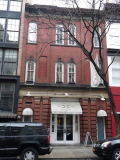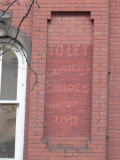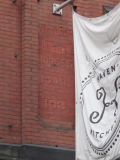
HERE’S a Forgotten NY touchstone at #109 West 17th (west of 6th Avenue) I have come back to over and over since its location was pointed out to me by painted sign maven Frank Jump at Frank Jump’s Fading Ads. It’s a carriage house that possibly has the oldest samples of exterior lettering still extant in NYC. The building was constructed in 1869-1870 by a prominent businessman named Thomas Lord, who as far as I know has no connections to the British department store magnate Samuel Lord, whose Lord & Taylor clothing store spent some time nearby at Broadway and East 20th Street. The building was originally two stories, with the stables on the ground floor and living quarters and a hay loft on the second floor. The third floor was added in 1895 by the building’s third owner — the arched window treatments were almost identically replicated.
The building was always used as a stable and for boarding horses by a succession of owners at least until the early 1900s. Alliance Paper and Twine occupied the building from 1918-1931 and then by Charles F. Wilson, a printer’s supplies dealer, who remained until the 1960s. Until at least the 1980s, lower 6th Avenue had been a paper supplies wholesaling mecca as well as wholesale shoes and socks district, all this coming after the great Ladies’ Mile emporiums had scattered uptown. Beginning in the 1980s, they returned, and Bed, Bath & Beyond, Men’s Warehouse, Old Navy attract thousands on weekends. One notable failure was the Barnes & Noble Books, which largely succumbed to Amazon and Kindle.
OK, the painted sign panels. There are two of them on the second floor, with one saying
TO LET
CARRIAGES
COUPES
HANSOMS
and the other one,
VICTORIAS
LIGHT WAGONS
HORSES
TAKEN IN BOARD
BY THE MONTH.
Both panels feature the address number, 109.
A carriage you’re no doubt familiar with, as those are the rigs that (so their advocates claim) overworked Central Park horses drag around in romantic rides through Central Park. A coupe (spelled with an accented E and pronounced koo-PAY in French) was a four-wheeled, horse-drawn carriage that was based on the larger coach (familiar from the western movies) but smaller and lighter; a hansom was a lightweight horse-drawn carriage invented by British architect George Hansom, light enough to be pulled by one horse.
On the other panel, a victoria was another carriage, but more luxurious and stylish. They were invented in France in the mid-1840s and imported to Britain in the 1860s, where they were nicknamed for Queen Victoria. Wagons were used to transport heavier materials and were pulled along by teams of horses or oxen. Lighter wagons were used to carry lighter materials.
I’d guess these signs are from the 1880s into the 1890s. There’s a certain swashiness (curved lettering) seen in those decades that you don’t see on 1860s and 1870s signage. It’s truly remarkable they’ve survived, as any of the building’s owners might decided to paint them over, but haven’t … yet.
The business on the ground floor has turned over a couple of times since I photographed the building in 2020, and taking a shot from across the street was impossible for awhile because of a sidewalk dining shed.
Check out the ForgottenBook, take a look at the gift shop. As always, “comment…as you see fit.” I earn a small payment when you click on any ad on the site.
6/18/25




